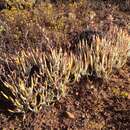pt-BR
nomes no trilho de navegação


Dudleya attenuata is a species of perennial succulent plant known by the common name taper-tip liveforever, native to Baja California and a small portion of California.[4] A rosette-forming leaf succulent, it has narrow pencil shaped leaves that can often be found covered in a white epicuticular wax. The thin, sprawling stems branch to form the clusters of rosettes, with plants creating a "clump" up to 40 cm wide. The small flowers are white or yellow, with 5 spreading petals. It is a diverse, variable species that extends from the southernmost coast of San Diego County to an area slightly north of the Vizcaino Desert, hybridizing with many other species of Dudleya in its range. Some plants with white or pinkish flowers were referred to as Orcutt's liveforever, referring to a former subspecies split on the basis of the flower color.
Because this is a very diverse and polymorphic species, this description serves as a generalization of the common features. See the taxonomy section for descriptions on the morphology of each subspecies.
The caudex is erect to sprawling, 3 to 15 mm thick. growing up to 30 cm or more long, branching to form clumps 10 to 40 cm wide, often covered in dried leaves. Rosettes are 2 to 5 cm wide, of 5 to 20 erect leaves. Leaves are farinose, linear to linear-oblanceolate, acute, terete, 2 to 10 cm long, 2 to 5 mm wide, with the base lenticular to suborbicular or oval 5 to 15 mm wide, 2 to 4 mm high, but sometimes higher than wide.[5][6]
Peduncles are 5 to 30 cm tall, 1 to 3 mm thick, leafy to within 1 to 4 cm of the base. The 5 to 15 bracts on the stem are ascending, linear-lanceolate to deltate-ovate, acute, with the lowermost 0.5 to 8 cm long and 2 to 5 mm wide. Higher on the inflorescence, it is composed of 1 to 3 simple branches 2 to 15 cm long, with 3 to 15 erect flowers mounted on pedicels 0.5 to 3 mm long.[5][6]
On the flower, the calyx is 3 to 6 mm wide, 2 to 5 mm high, segmented into deltate-ovate sepals with an acute tip, 1.5 to 4 mm long, 1 to 2 mm wide. The corolla is cream, white or pinkish, with the keel finely marked in red. Petals are 5 to 11 mm long, 1.5 to 4 mm wide. Concerning the stamens, filaments are 3.5 to 11 mm long, and the anthers are red to yellow, 1 to 2 mm long. Seeds are reddish brown, 0.7 to 1 mm long.
Plants are diploid, typically with n = 17 chromosomes.[5][6]
This species hybridizes widely across its range. Parents of hybrids with Dudleya attenuata subsp. attenuata include D. candida, D. edulis, D. formosa, D. ingens, and D. variegata. A recurrent hybrid, known as D. × semiteres, is somewhat common compared to other crosses. The southern subspecies, Dudleya attenuata subsp. australis, is found hybridizing where Dudleya albiflora meets it in the south near Puerto Faro San José.[9][6]
The taxonomic status of D. attenuata's subspecies is still under debate. Phylogenetic analysis reveals that although some specimens of D. attenuata from Punta Banda are sister to D. a. subsp. attenuata, other specimens collected are instead basal to D. edulis and D. formosa, illustrating the gene flow where the species overlap.[7]
D. attenuata is nearly endemic to Baja California with the exception of a population north of the border in San Diego County, California, at the Border Field State Park. It is also occurrent offshore on the Coronado Islands and the Isla Todos Santos. It can be found on coastal bluffs, typically below 165 ft.
The D. attenuata population in the United States is threatened by Border Patrol activity and trampling.[11]
In habitat in Ensenada
Specimen in El Rosario
Specimen in Ensenada
Specimen in Ensenada
Dudleya attenuata is a species of perennial succulent plant known by the common name taper-tip liveforever, native to Baja California and a small portion of California. A rosette-forming leaf succulent, it has narrow pencil shaped leaves that can often be found covered in a white epicuticular wax. The thin, sprawling stems branch to form the clusters of rosettes, with plants creating a "clump" up to 40 cm wide. The small flowers are white or yellow, with 5 spreading petals. It is a diverse, variable species that extends from the southernmost coast of San Diego County to an area slightly north of the Vizcaino Desert, hybridizing with many other species of Dudleya in its range. Some plants with white or pinkish flowers were referred to as Orcutt's liveforever, referring to a former subspecies split on the basis of the flower color.
Dudleya attenuata é uma espécie de planta nativa da Califórnia e da Baixa Califórnia.[4]
Folhas desta espécie têm até 5 mm de espessura. As flores são abertas em vez de tubulares, e tem menos flores do que a maioria das espécies relacionadas.[4]
Dudleya attenuata é uma espécie de planta nativa da Califórnia e da Baixa Califórnia.
Folhas desta espécie têm até 5 mm de espessura. As flores são abertas em vez de tubulares, e tem menos flores do que a maioria das espécies relacionadas.
Dudleya attenuata là một loài thực vật có hoa trong họ Crassulaceae. Loài này được (S.Watson) Moran miêu tả khoa học đầu tiên năm 1943.[1]
Dudleya attenuata là một loài thực vật có hoa trong họ Crassulaceae. Loài này được (S.Watson) Moran miêu tả khoa học đầu tiên năm 1943.